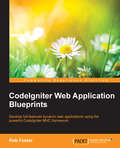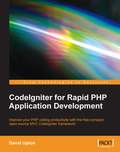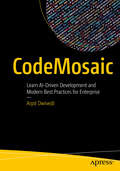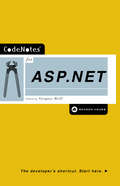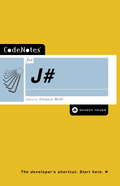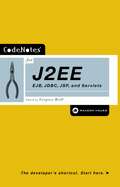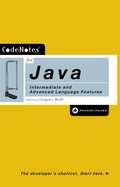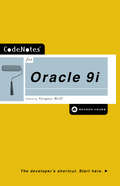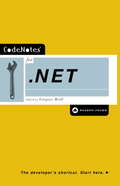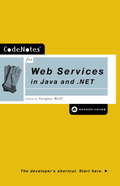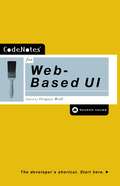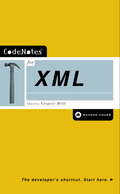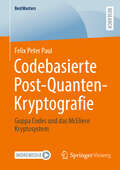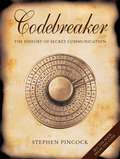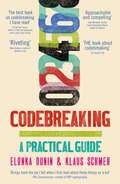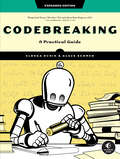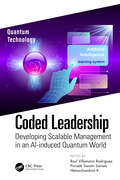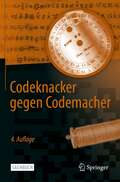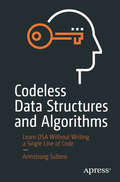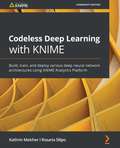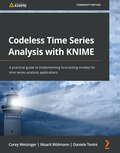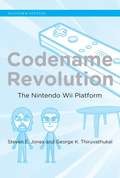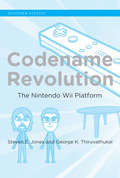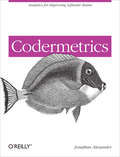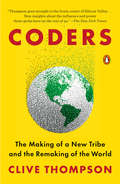- Table View
- List View
CodeIgniter Web Application Blueprints
by Rob FosterIf you are a PHP programmer or developer looking for a framework to quickly develop your applications, this book is for you. The prerequisites needed would be prior experience with CodeIgniter.
CodeIgniter for Rapid PHP Application Development
by David UptonThis book steps you through the main features of CodeIgniter in a systematic way, explaining them clearly with illustrative code examples. This book is for developers who are new to CodeIgniter. Basic skills in PHP and MySQL are required, but only rudimentary object-oriented knowledge is required. If you're looking for a better way to develop PHP applications, or want to find out more about the CodeIgniter framework as a viable option for one of your own projects, this book will help you.
CodeMosaic: Learn AI-Driven Development and Modern Best Practices for Enterprise
by Arpit DwivediThis book is a comprehensive guide for those navigating through the complexities of enterprise software development. For fresh graduates, transitioning from college projects to real-world applications can be overwhelming. This book acts as a roadmap, helping you bridge the gap to become industry-ready. It's like an intensive internship in book form, equipping readers with the skills and knowledge needed for modern tech roles. But it's not just for newcomers. Even experienced developers can get caught up in old routines and miss out on new tools and techniques. With the rise of AI and automation tools like ChatGPT and Copilot, the development landscape is rapidly changing. The core of the book revolves around practical application. Using .NET, Angular, and other Microsoft technologies as foundational pillars, you’ll embark on a hands-on journey. From understanding the basics to designing and deploying a full-stack web application, CodeMosaic offers a holistic learning experience. By the end, you won't just be a developer; you'll be well-equipped to tackle the challenges of today's digital world. What You'll Learn Review Agile methodologies and Azure DevOps for streamlined project management. Gain a thorough understanding of smart development from design to deployment. Master software development with .NET and Angular, along with effective version control using Git. Enhance your coding and design skills using GitHub Copilot, GPT technologies, and AI-driven prompt engineering. Who This Book Is For Experienced developers looking for new tools and techniques, and recent graduates, transitioning from college projects to real-world applications.
CodeNotes for ASP.NET
by Gregory BrillCodeNotes provides the most succinct, accurate, and speedy way fora developer to ramp up on a new technology or language.Unlike other programming books, CodeNotes drills down tothe core aspects of a technology, focusing on the key elements needed in order to implement it immediately. It is a unique resource fordevelopers, filling the gap between comprehensive manuals andpocket references.CodeNotes for ASP.NET is a revolutionary update to Microsoft's Active Server Pages. This edition explores how Web applications and Web services can be developed using ASP.NET. The .NET architecture, Base Class Libraries, ASP.NET form designer,Web controls, and cross-page and cross-language debuggingare discussed. Scaling ASP.NET to multiple servers,state management, security, and methods of enhancing performance are also covered. This edition of CodeNotes includes:* Real-world examples* "How and Why" and "Bugs and Caveats" sections that provide workarounds and tips on what should be taken advantage of or avoided* "Design Notes" illustrating many of the common use patterns for Java programs* Instructions and classroom-style tutorials throughout from expertsVisit www.codenotes.com for updates, source code templates, access tomessage boards, and discussion of specific problems withCodeNotes authors and other developers.Join our nonfiction newsletter by sending a blank e-mail to:join-rht-nonfiction@list.randomhouse.com or visit www.atrandom.comEvery CodeNotes title is written and reviewed by a team of commercial software developers and technology experts. See "About the Authors" at the front of the book for more information.From the Trade Paperback edition.
CodeNotes for C#
by Gregory BrillCodeNotes provides the most succinct, accurate, and speedy way for a developer to ramp up on a new technology or language. Unlike other programming books, CodeNotes drills down to the core aspects of a technology, focusing on the key elements needed in order to understand it quickly and implement it immediately. It is a unique resource for developers, filling the gap between comprehensive manuals and pocket references. CodeNotes for C# illustrates Microsoft's new language for the . NET platform, emphasizing syntax features and object-oriented concepts. Major capabilities of the . NET platform, including the Common Language Runtime (CLR), Base Class Libraries (BCL), and Assemblies, are also covered, as are popular . NET services such as ADO. NET, web services, and ASP. NET. This book is aimed at the experienced developer (Java, VB, C++, etc. ) who wants to learn the C# language and evaluate its new features. This edition of CodeNotes includes: * A global overview of this technology and explanation of what problems it can be used to solve * Real-world examples * "How and Why" sections that provide hints, tricks, workarounds, and tips on what should be taken advantage of or avoided * Instructions and classroom-style tutorials throughout from expert trainers and software developers
CodeNotes for J2EE: EJB, JDBC, JSP and Servlets (CodeNotes)
by Gregory BrillCodeNotes provides the most succinct, accurate, and speedy way for a developer to ramp up on a new technology or language. Unlike other programming books, CodeNotes drills down to the core aspects of a technology, focusing on the key elements needed in order to understand it quickly and implement it immediately. It is a unique resource for developers, filling the gap between comprehensive manuals and pocket reference.CodeNotes for J2EE: EJB, JDBC, JSP, and Servlets introduces Java developers to the key database and web development technologies of the Java 2 Platform, Enterprise Edition. The JDBC API, JavaServer Pages, and Servlet frameworks are covered individually with examples that show how these technologies work together to create robust, dynamic web-based applications. The book also explains how to use Enterprise JavaBeans to create large, distributed, scalable applications.This edition of CodeNotes includes:-A global overview of a technology and explanation of what problems it can be used to solve-Real-world examples-"How and Why," "Design Notes," and "Bugs and Caveats" sections that provide hints, tricks, workarounds, and tips on what should be taken advantage of or avoided-Instructions and classroom-style tutorials throughout from expert trainers and software developersVisit www.codenotes.com for updates, source code templates, access to message boards, and discussion of specific problems with CodeNotes authors and other developers.Every CodeNotes title is written and reviewed by a team of commercial software developers and technology experts. See "About the Authors" at the beginning of the book for more information.
CodeNotes for Java: Intermediate and Advanced Language Features (CodeNotes)
by Gregory BrillCodeNotes provides the most succinct, accurate, and speedy way for a developer to ramp up on a new technology or language. Unlike other programming books, CodeNotes drills down to the core aspects of a technology, focusing on the key elements needed in order to understand it quickly and implement it immediately. It is a unique resource for developers, filling the gap between comprehensive manuals and pocket references. CodeNotes for Web Services in Java and . NET examines the core specifications and technologies required for building SOAP-based web services in both Java and . NET. Not only will you find descriptions of SOAP, WSDL, and UDDI; you will also see how to use each of these specifications with Java and . NET. In addition, you will find specific sections on cross-language and cross-platform compatibility between web services. This edition of CodeNotes includes: * A global overview of this technology and explanation of what problems it can be used to solve * Real-world examples * "How and Why" sections that provide hints, tricks, workarounds, and tips on what should be taken advantage of or avoided * Instructions and classroom-style tutorials throughout from expert trainers and software developers
CodeNotes for Oracle 9i
by Gregory BrillCodeNotes provides the most succinct, accurate, and speedy way fora developer to ramp up on a new technology or language.Unlike other programming books, CodeNotes drills down tothe core aspects of a technology, focusing on the key elements needed in order to implement it immediately. It is a unique resource fordevelopers, filling the gap between comprehensive manuals andpocket references.Through real-world examples of PL/SQL queries, stored procedures, triggers, indexing, and more, CodeNotes for Oracle 9i illustrates the complete Oracle database framework, PL/SQL, security, administration, and optimization. Oracle's integration with Java and support for XML are extensively covered. This edition of CodeNotes includes:* A global overview of this technology and explanation of what problems it can be used to solve* Real-world examples* "How and Why" and "Bugs and Caveats" sections that provide hints, tricks, workarounds, and tips on what should be taken advantage of or avoided* "Design Notes" illustrating many of the common use patterns for Java programs* Instructions and classroom-style tutorials throughout from expert trainers and software developersVisit www.codenotes.com for updates, source code templates, access tomessage boards, and discussion of specific problems withCodeNotes authors and other developers.Join our nonfiction newsletter by sending a blank e-mail to:join-rht-nonfiction@list.randomhouse.com or visit www.atrandom.comEvery CodeNotes title is written and reviewed by a team of commercial software developers and technology experts. See "About the Authors" at the front of the book for more information.From the Trade Paperback edition.
CodeNotes for VB.NET
by Gregory BrillCodeNotes provides the most succinct, accurate, and speedy way for a developer to ramp up on a new technology or language. Unlike other programming books, CodeNotes drills down to the core aspects of a technology, focusing on the key elements needed in order to understand it quickly and implement it immediately. It is a unique resource for developers, filling the gap between comprehensive manuals and pocket references.CodeNotes for VB.NET illustrates the major changes in Visual Basic with the new .NET edition, emphasizing the Common Language Runtime (CLR), syntax changes, Windows Forms, assemblies, new object oriented programming features, threading, and a survey of new .NET technologies such as ADO.NET, ASP.NET, and SOAP. This book will help any level of VB developer understand the power of VB.NET and learn the necessary techniques to transition from VB6 to VB.NET. This edition of CodeNotes includes:-A global overview of a technology and explanation of what problems it can be used to solve-Real-world examples-"How and Why" sections that provide hints, tricks, workarounds, and tips on what should be taken advantage of or avoided-Instructions and classroom-style tutorials throughout from expert trainers and software developersVisit www.codenotes.com for updates, source code templates, access to message boards, and discussion of specific problems with CodeNotes authors and other developers.Every CodeNotes title is written and reviewed by a team of commercial software developers and technology experts. See "About the Authors" at the beginning of the book for more information.
CodeNotes for Web Services in Java and .NET
by Gregory BrillCodeNotes provides the most succinct, accurate, and speedy way for a developer to ramp up on a new technology or language. Unlike other programming books, CodeNotes drills down to the core aspects of a technology, focusing on the key elements needed in order to understand it quickly and implement it immediately. It is a unique resource for developers, filling the gap between comprehensive manuals and pocket references. CodeNotes for Web Services in Java and . NET examines the core specifications and technologies required for building SOAP-based web services in both Java and . NET. Not only will you find descriptions of SOAP, WSDL, and UDDI; you will also see how to use each of these specifications with Java and . NET. In addition, you will find specific sections on cross-language and cross-platform compatibility between web services. This edition of CodeNotes includes: * A global overview of this technology and explanation of what problems it can be used to solve * Real-world examples * "How and Why" sections that provide hints, tricks, workarounds, and tips on what should be taken advantage of or avoided * Instructions and classroom-style tutorials throughout from expert trainers and software developers
CodeNotes for Web-Based UI
by Edited by Gregory BrillCodeNotes provides the most succinct, accurate, and speedy way for a developer to ramp up on a new technology or language. Unlike other programming books, CodeNotes drills down to the core aspects of a technology, focusing on the key elements needed in order to understand it quickly and implement it immediately. It is a unique resource for developers, filling the gap between comprehensive manuals and pocket references.CodeNotes for Web-Based UI shows how to build sophisticated, high-performance UIs for web-based applications using technologies such as JavaScript, DHTML, and CSS as well as XML and XSLT. It also details how to leverage technology and solve common web-based presentation and manipulation problems. Web designers and programmers will both develop a better understanding of common web-based design challenges, and discover some common approaches to solving these problems. This edition of CodeNotes includes:-A global overview of a technology and explanation of what problems it can be used to solve-Real-world examples-"How and Why" and "Design Notes" sections that provide hints, tricks, workarounds, and tips on what should be taken advantage of or avoided-Instructions and classroom-style tutorials throughout from expert trainers and software developersVisit www.codenotes.com for updates, source code templates, access to message boards, and discussion of specific problems with CodeNotes authors and other developers.Every CodeNotes title is written and reviewed by a team of commercial software developers and technology experts. See "About the Authors" at the beginning of the book for more information.
CodeNotes for XML
by Gregory BrillCodeNotes provides the most succinct, accurate, and speedy way for a developer to ramp up on a new technology or language. Unlike other programming books, CodeNotes drills down to the core aspects of a technology, focusing on the key elements needed in order to understand it quickly and implement it immediately. It is a unique resource for developers, filling the gap between comprehensive manuals and pocket references.CodeNotes for XML is a practical handbook for Java and Visual Basic developers interested in working with XML. You will learn how to leverage both CSS and XSLT to produce rich, compelling output, as well as manipulate XML using the DOM and SAX APIs. The new XML Schema specification is also covered in-depth. Companion articles on www.codenotes.com cover XML development with Perl, integrating XML with databases, important grammars such as XHTML and SOAP, and much more. CodeNotes for XML is your guide to these powerful technologies, presented within the context of the distributed application, database, or web-based world you already know. This edition of CodeNotes includes:-A global overview of a technology and explanation of what problems it can be used to solve-Real-world examples-"How and Why" and "Bugs and Caveats" sections that provide hints, tricks, workarounds, and tips on what should be taken advantage of or avoided-Instructions and classroom-style tutorials throughout from expert trainers and software developers.Visit www.codenotes.com for updates, source code templates, access to message boards, and discussion of specific problems with CodeNotes authors and other developers.Every CodeNotes title is written and reviewed by a team of commercial software developers and technology experts. See "About the Authors" for more information.
Codebasierte Post-Quanten-Kryptografie: Goppa Codes und das McEliece Kryptosystem (BestMasters)
by Felix Peter PaulEntdecken Sie die Zukunft der Kryptographie mit „Codebasierte Post-Quanten-Kryptografie - Goppa Codes und das McEliece Kryptosystem“. Dieses Buch bietet eine grundlegende und detaillierte Einführung in eines der sichersten Kryptosysteme unserer Zeit – das McEliece-Kryptosystem. Ursprünglich 1978 entwickelt, widersteht es den modernsten Bedrohungen durch Quantencomputer und setzt neue Maßstäbe in der Post-Quanten-Kryptografie. Mit einer umfassenden Analyse der Goppa Codes und einer verständlichen Darstellung sowohl der Theorie als auch der praktischen Implementierung, ist dieses Werk ein unverzichtbarer Begleiter für jeden, der sich für die nächste Generation der Datensicherheit interessiert. Neben tiefgehenden technischen Einblick erhält man mit dem Buch Zugriff auf eine Implementierung, die es Lesern ermöglicht, die Konzepte interaktiv zu erkunden. Ein Muss für Fachleute der IT-Sicherheit, Akademiker und jeden, der ein tiefes Verständnis für die Mechanismen quantensicherer Verschlüsselung entwickeln möchte.
Codebreaker: The History of Codes and Ciphers, from the Ancient Pharaohs to Quantum Cryptography
by Stephen Pincock"Codebreaker chronicles the story of codes -- from Julius Caesar and Mary Queen of Scots to quantum cryptography and the next generation -- and the historical events that have turned on them. But however eye-opening are the inner workings of the Caesar shift cipher or the codes of the Navajo Windtalkers, even more intriguing is the allure of unsolved codes. Codebreaker profiles some of those hailed as unbreakable, such as the magnificent Dorabella and Beale Ciphers and the Voynich manuscript." --BOOK JACKET.
Codebreaking: A Practical Guide
by Klaus Schmeh Elonka Dunin'The best book on codebreaking I have read', SIR DERMOT TURING 'Brings back the joy I felt when I first read about these things as a kid', PHIL ZIMMERMANN 'This is at last the single book on codebreaking that you must have. If you are not yet addicted to cryptography, this book will get you addicted. Read, enjoy, and test yourself on history's great still-unbroken messages!' JARED DIAMOND is the Pulitzer Prize-winning author of Guns, Germs, and Steel; Collapse; and other international bestsellers'This is THE book about codebreaking. Very concise, very inclusive and easy to read', ED SCHEIDT'Riveting', MIKE GODWIN 'Approachable and compelling', GLEN MIRANKERThis practical guide to breaking codes and solving cryptograms by two world experts, Elonka Dunin and Klaus Schmeh, describes the most common encryption techniques along with methods to detect and break them. It fills a gap left by outdated or very basic-level books. This guide also covers many unsolved messages. The Zodiac Killer sent four encrypted messages to the police. One was solved; the other three were not. Beatrix Potter's diary and the Voynich Manuscript were both encrypted - to date, only one of the two has been deciphered. The breaking of the so-called Zimmerman Telegram during the First World War changed the course of history. Several encrypted wartime military messages remain unsolved to this day. Tens of thousands of other encrypted messages, ranging from simple notes created by children to encrypted postcards and diaries in people's attics, are known to exist. Breaking these cryptograms fascinates people all over the world, and often gives people insight into the lives of their ancestors. Geocachers, computer gamers and puzzle fans also require codebreaking skills.This is a book both for the growing number of enthusiasts obsessed with real-world mysteries, and also fans of more challenging puzzle books. Many people are obsessed with trying to solve famous crypto mysteries, including members of the Kryptos community (led by Elonka Dunin) trying to solve a decades-old cryptogram on a sculpture at the centre of CIA Headquarters; readers of the novels of Dan Brown as well as Elonka Dunin's The Mammoth Book of Secret Code Puzzles (UK)/The Mammoth Book of Secret Codes and Cryptograms (US); historians who regularly encounter encrypted documents; perplexed family members who discover an encrypted postcard or diary in an ancestor's effects; law-enforcement agents who are confronted by encrypted messages, which also happens more often than might be supposed; members of the American Cryptogram Association (ACA); geocachers (many caches involve a crypto puzzle); puzzle fans; and computer gamers (many games feature encryption puzzles). The book's focus is very much on breaking pencil-and-paper, or manual, encryption methods. Its focus is also largely on historical encryption. Although manual encryption has lost much of its importance due to computer technology, many people are still interested in deciphering messages of this kind.
Codebreaking: A Practical Guide
by Klaus Schmeh Elonka DuninIf you liked Dan Brown&’s Da Vinci Code—or want to solve similarly baffling cyphers yourself—this is the book for you! A thrilling exploration of history&’s most vexing codes and ciphers that uses hands-on exercises to teach you the most popular historical encryption schemes and techniques for breaking them.Solve history&’s most hidden secrets alongside expert codebreakers Elonka Dunin and Klaus Schmeh, as they guide you through the world of encrypted texts. With a focus on cracking real-world document encryptions—including some crime-based coded mysteries that remain unsolved—you&’ll be introduced to the free computer software that professional cryptographers use, helping you build your skills with state-of-the art tools. You&’ll also be inspired by thrilling success stories, like how the first three parts of Kryptos were broken. Each chapter introduces you to a specific cryptanalysis technique, and presents factual examples of text encrypted using that scheme—from modern postcards to 19-century newspaper ads, war-time telegrams, notes smuggled into prisons, and even entire books written in code. Along the way, you&’ll work on NSA-developed challenges, detect and break a Caesar cipher, crack an encrypted journal from the movie The Prestige, and much more.You&’ll learn: How to crack simple substitution, polyalphabetic, and transposition ciphers How to use free online cryptanalysis software, like CrypTool 2, to aid your analysisHow to identify clues and patterns to figure out what encryption scheme is being usedHow to encrypt your own emails and secret messagesCodebreaking is the most up-to-date resource on cryptanalysis published since World War II—essential for modern forensic codebreakers, and designed to help amateurs unlock some of history&’s greatest mysteries.
Coded Leadership: Developing Scalable Management in an AI-induced Quantum World
by Hemachandran K Raul Villamarin Rodriguez Pinisetti Swami SairamCoded Leadership: Developing Scalable Management in an AI-induced Quantum World will assist researchers and industry experts working towards improvising their processes and developing and deploying strategies in an AI-induced world of quantum computing. The book introduces the necessary background to understand the challenges in today’s organizational leadership and how artificial intelligence enables learning to be viewed from a probabilistic framework. Key Features Introduction to Quantum Natural Language Processing. Overview of Leadership and AI. The Age of Quantum Superiority. Challenges to Today’s Leadership. AI-induced Strategic Implementation and Organizational Performance. This book serves as a reference for researchers that need to know how AI and quantum can assist in leadership and organizational performance. The book will also be helpful for students that want to learn more about AI and quantum computing in various business applications.
Codeknacker gegen Codemacher: Die faszinierende Geschichte der Verschlüsselung
by Klaus SchmehDie Verschlüsselungstechnik (Kryptologie) hat eine spannende Geschichte. Sie ist geprägt dramatischen Begebenheiten, genialen Codeknackern und ungelösten Rätseln. Das Voynich-Manuskript – ein verschlüsseltes Buch aus dem Mittelalter – fasziniert genauso wie die Verschlüsselungsmaschine Enigma oder der berüchtigte Zodiac-Killer. Klaus Schmeh hat aus der umfangreichen Geschichte dieser Wissenschaft die spannendsten Episoden ausgewählt und erzählt sie in mitreißender Weise.
Codeless Data Structures and Algorithms: Learn DSA Without Writing a Single Line of Code
by Armstrong SuberoIn the era of self-taught developers and programmers, essential topics in the industry are frequently learned without a formal academic foundation. A solid grasp of data structures and algorithms (DSA) is imperative for anyone looking to do professional software development and engineering, but classes in the subject can be dry or spend too much time on theory and unnecessary readings. Regardless of your programming language background, Codeless Data Structures and Algorithms has you covered.In this book, author Armstrong Subero will help you learn DSAs without writing a single line of code. Straightforward explanations and diagrams give you a confident handle on the topic while ensuring you never have to open your code editor, use a compiler, or look at an integrated development environment. Subero introduces you to linear, tree, and hash data structures and gives you important insights behind the most common algorithms that you can directly apply to your own programs. Codeless Data Structures and Algorithms provides you with the knowledge about DSAs that you will need in the professional programming world, without using any complex mathematics or irrelevant information. Whether you are a new developer seeking a basic understanding of the subject or a decision-maker wanting a grasp of algorithms to apply to your projects, this book belongs on your shelf. Quite often, a new, refreshing, and unpretentious approach to a topic is all you need to get inspired. What You'll LearnUnderstand tree data structures without delving into unnecessary details or going into too much theoryGet started learning linear data structures with a basic discussion on computer memory Study an overview of arrays, linked lists, stacks and queuesWho This Book Is ForThis book is for beginners, self-taught developers and programmers, and anyone who wants to understand data structures and algorithms but don’t want to wade through unnecessary details about quirks of a programming language or don’t have time to sit and read a massive book on the subject. This book is also useful for non-technical decision-makers who are curious about how algorithms work.
Codeless Deep Learning with KNIME: Build, Train, And Deploy Various Deep Neural Network Architectures Using Knime Analytics Platform
by Rosaria Silipo Kathrin MelcherThis book is for data analysts, data scientists, and deep learning developers who are not well versed with Python but want to learn how to use KNIME GUI to build, train, test, and deploy neural networks with different architectures. The practical implementations shown in the book do not require coding or any knowledge of dedicated scripts, allowing you to quickly translate theoretical concepts into practical applications. No previous knowledge of KNIME is required.
Codeless Time Series Analysis with KNIME: A practical guide to implementing forecasting models for time series analysis applications
by Corey Weisinger Maarit Widmann Daniele ToniniPerform time series analysis using KNIME Analytics Platform, covering both statistical methods and machine learning-based methodsKey FeaturesGain a solid understanding of time series analysis and its applications using KNIMELearn how to apply popular statistical and machine learning time series analysis techniquesIntegrate other tools such as Spark, H2O, and Keras with KNIME within the same applicationBook DescriptionThis book will take you on a practical journey, teaching you how to implement solutions for many use cases involving time series analysis techniques.This learning journey is organized in a crescendo of difficulty, starting from the easiest yet effective techniques applied to weather forecasting, then introducing ARIMA and its variations, moving on to machine learning for audio signal classification, training deep learning architectures to predict glucose levels and electrical energy demand, and ending with an approach to anomaly detection in IoT. There's no time series analysis book without a solution for stock price predictions and you'll find this use case at the end of the book, together with a few more demand prediction use cases that rely on the integration of KNIME Analytics Platform and other external tools.By the end of this time series book, you'll have learned about popular time series analysis techniques and algorithms, KNIME Analytics Platform, its time series extension, and how to apply both to common use cases.What you will learnInstall and configure KNIME time series integrationImplement common preprocessing techniques before analyzing dataVisualize and display time series data in the form of plots and graphsSeparate time series data into trends, seasonality, and residualsTrain and deploy FFNN and LSTM to perform predictive analysisUse multivariate analysis by enabling GPU training for neural networksTrain and deploy an ML-based forecasting model using Spark and H2OWho this book is forThis book is for data analysts and data scientists who want to develop forecasting applications on time series data. While no coding skills are required thanks to the codeless implementation of the examples, basic knowledge of KNIME Analytics Platform is assumed. The first part of the book targets beginners in time series analysis, and the subsequent parts of the book challenge both beginners as well as advanced users by introducing real-world time series applications.
Codename Revolution
by Steven Jones George ThiruvathukalThe Nintendo Wii, introduced in 2006, helped usher in a moment of retro-reinvention in video game play. This hugely popular console system, codenamed Revolution during development, signaled a turn away from fully immersive, time-consuming MMORPGs or forty-hour FPS games and back toward family fun in the living room. Players using the wireless motion-sensitive controller (the Wii Remote, or "Wiimote") play with their whole bodies, waving, swinging, swaying. The mimetic interface shifts attention from what's on the screen to what's happening in physical space. This book describes the Wii's impact in technological, social, and cultural terms, examining the Wii as a system of interrelated hardware and software that was consciously designed to promote social play in physical space. Each chapter of Codename Revolution focuses on a major component of the Wii as a platform: the console itself, designed to be low-powered and nimble; the iconic Wii Remote; Wii Fit Plus, and its controller, the Wii Balance Board; the Wii Channels interface and Nintendo's distribution system; and the Wii as a social platform that not only affords multiplayer options but also encourages social interaction in shared physical space. Finally, the authors connect the Wii's revolution in mimetic interface gaming--which eventually led to the release of Sony's Move and Microsoft's Kinect--to some of the economic and technological conditions that influence the possibility of making something new in this arena of computing and culture.
Codename Revolution: The Nintendo Wii Platform (Platform Studies)
by Steven E. Jones George K. ThiruvathukalNintendo's hugely popular and influential video game console system considered as technological device and social phenomenon.The Nintendo Wii, introduced in 2006, helped usher in a moment of retro-reinvention in video game play. This hugely popular console system, codenamed Revolution during development, signaled a turn away from fully immersive, time-consuming MMORPGs or forty-hour FPS games and back toward family fun in the living room. Players using the wireless motion-sensitive controller (the Wii Remote, or “Wiimote”) play with their whole bodies, waving, swinging, swaying. The mimetic interface shifts attention from what's on the screen to what's happening in physical space. This book describes the Wii's impact in technological, social, and cultural terms, examining the Wii as a system of interrelated hardware and software that was consciously designed to promote social play in physical space.Each chapter of Codename Revolution focuses on a major component of the Wii as a platform: the console itself, designed to be low-powered and nimble; the iconic Wii Remote; Wii Fit Plus, and its controller, the Wii Balance Board; the Wii Channels interface and Nintendo's distribution system; and the Wii as a social platform that not only affords multiplayer options but also encourages social interaction in shared physical space. Finally, the authors connect the Wii's revolution in mimetic interface gaming—which eventually led to the release of Sony's Move and Microsoft's Kinect—to some of the economic and technological conditions that influence the possibility of making something new in this arena of computing and culture.
Codermetrics: Analytics for Improving Software Teams (O'reilly Ser.)
by Jonathan AlexanderHow can you help your software team improve? This concise book introduces codermetrics, a clear and objective way to identify, analyze, and discuss the successes and failures of software engineers—not as part of a performance review, but as a way to make the team a more cohesive and productive unit.Experienced team builder Jonathan Alexander explains how codermetrics helps teams understand exactly what occurred during a project, and enables each coder to focus on specific improvements. Alexander presents a variety of simple and complex codermetrics, and teaches you how to create your own.Learn how codermetrics changes long-held assumptions and improves team dynamicsGet recommendations for integrating codermetrics into existing processesAsk the right questions to determine the type of data you need to collectUse metrics to measure individual coder skills and a team’s effectiveness over timeIdentify the contributions each coder makes to the teamAnalyze the response to your software and its features—and verify that you're meeting team and organizational goalsBuild better teams, using codermetrics to make personnel adjustments and additions
Coders: The Making of a New Tribe and the Remaking of the World
by Clive ThompsonHello, world.Facebook's algorithms shaping the news. Self-driving cars roaming the streets. Revolution on Twitter and romance on Tinder. We live in a world constructed of code--and coders are the ones who built it for us. From acclaimed tech writer Clive Thompson comes a brilliant anthropological reckoning with the most powerful tribe in the world today, computer programmers, in a book that interrogates who they are, how they think, what qualifies as greatness in their world, and what should give us pause. They are the most quietly influential people on the planet, and Coders shines a light on their culture.In pop culture and media, the people who create the code that rules our world are regularly portrayed in hackneyed, simplified terms, as ciphers in hoodies. Thompson goes far deeper, dramatizing the psychology of the invisible architects of the culture, exploring their passions and their values, as well as their messy history. In nuanced portraits, Coders takes us close to some of the great programmers of our time, including the creators of Facebook's News Feed, Instagram, Google's cutting-edge AI, and more. Speaking to everyone from revered "10X" elites to neophytes, back-end engineers and front-end designers, Thompson explores the distinctive psychology of this vocation--which combines a love of logic, an obsession with efficiency, the joy of puzzle-solving, and a superhuman tolerance for mind-bending frustration. Along the way, Coders thoughtfully ponders the morality and politics of code, including its implications for civic life and the economy. Programmers shape our everyday behavior: When they make something easy to do, we do more of it. When they make it hard or impossible, we do less of it. Thompson wrestles with the major controversies of our era, from the "disruption" fetish of Silicon Valley to the struggle for inclusion by marginalized groups.In his accessible, erudite style, Thompson unpacks the surprising history of the field, beginning with the first coders -- brilliant and pioneering women, who, despite crafting some of the earliest personal computers and programming languages, were later written out of history. Coders introduces modern crypto-hackers fighting for your privacy, AI engineers building eerie new forms of machine cognition, teenage girls losing sleep at 24/7 hackathons, and unemployed Kentucky coal-miners learning a new career. At the same time, the book deftly illustrates how programming has become a marvelous new art form--a source of delight and creativity, not merely danger. To get as close to his subject as possible, Thompson picks up the thread of his own long-abandoned coding skills as he reckons, in his signature, highly personal style, with what superb programming looks like. To understand the world today, we need to understand code and its consequences. With Coders, Thompson gives a definitive look into the heart of the machine.
